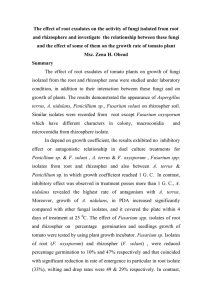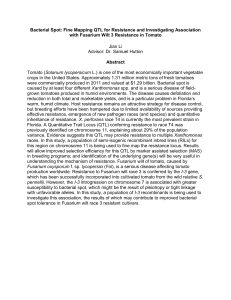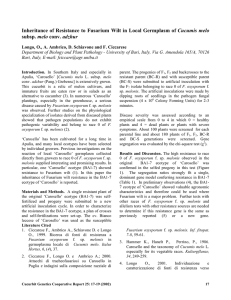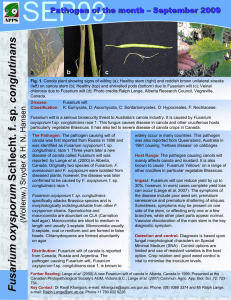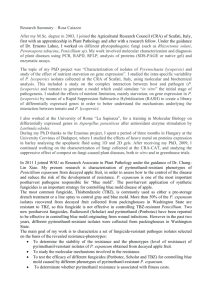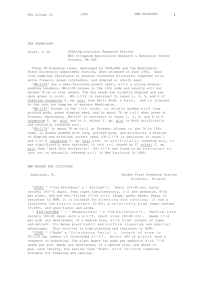In vitro cellulase activity of two wilt causing soil fusaria (Fusarium solani and F. oxysporum f. sp. lycopersici) and efficacy of some pesticides against the said fusaria
advertisement
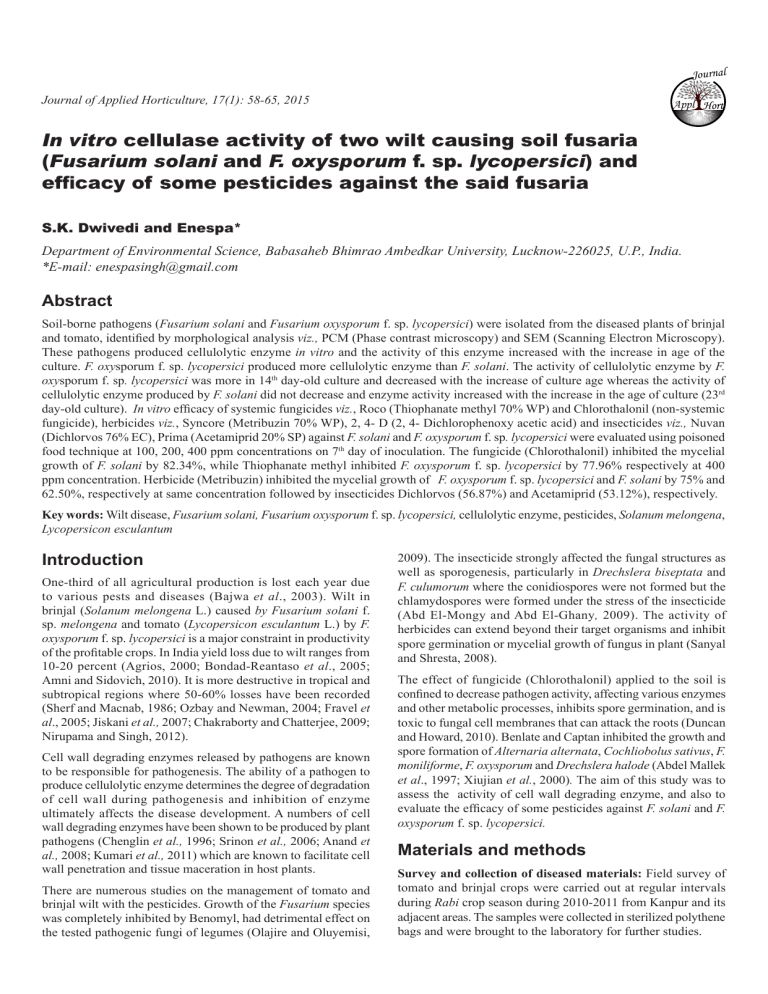
Journal Journal of Applied Horticulture, 17(1): 58-65, 2015 Appl In vitro cellulase activity of two wilt causing soil fusaria (Fusarium solani and F. oxysporum f. sp. lycopersici) and efficacy of some pesticides against the said fusaria S.K. Dwivedi and Enespa* Department of Environmental Science, Babasaheb Bhimrao Ambedkar University, Lucknow-226025, U.P., India. *E-mail: enespasingh@gmail.com Abstract Soil-borne pathogens (Fusarium solani and Fusarium oxysporum f. sp. lycopersici) were isolated from the diseased plants of brinjal and tomato, identified by morphological analysis viz., PCM (Phase contrast microscopy) and SEM (Scanning Electron Microscopy). These pathogens produced cellulolytic enzyme in vitro and the activity of this enzyme increased with the increase in age of the culture. F. oxysporum f. sp. lycopersici produced more cellulolytic enzyme than F. solani. The activity of cellulolytic enzyme by F. oxysporum f. sp. lycopersici was more in 14th day-old culture and decreased with the increase of culture age whereas the activity of cellulolytic enzyme produced by F. solani did not decrease and enzyme activity increased with the increase in the age of culture (23rd day-old culture). In vitro efficacy of systemic fungicides viz., Roco (Thiophanate methyl 70% WP) and Chlorothalonil (non-systemic fungicide), herbicides viz., Syncore (Metribuzin 70% WP), 2, 4- D (2, 4- Dichlorophenoxy acetic acid) and insecticides viz., Nuvan (Dichlorvos 76% EC), Prima (Acetamiprid 20% SP) against F. solani and F. oxysporum f. sp. lycopersici were evaluated using poisoned food technique at 100, 200, 400 ppm concentrations on 7th day of inoculation. The fungicide (Chlorothalonil) inhibited the mycelial growth of F. solani by 82.34%, while Thiophanate methyl inhibited F. oxysporum f. sp. lycopersici by 77.96% respectively at 400 ppm concentration. Herbicide (Metribuzin) inhibited the mycelial growth of F. oxysporum f. sp. lycopersici and F. solani by 75% and 62.50%, respectively at same concentration followed by insecticides Dichlorvos (56.87%) and Acetamiprid (53.12%), respectively. Key words: Wilt disease, Fusarium solani, Fusarium oxysporum f. sp. lycopersici, cellulolytic enzyme, pesticides, Solanum melongena, Lycopersicon esculantum Introduction One-third of all agricultural production is lost each year due to various pests and diseases (Bajwa et al., 2003). Wilt in brinjal (Solanum melongena L.) caused by Fusarium solani f. sp. melongena and tomato (Lycopersicon esculantum L.) by F. oxysporum f. sp. lycopersici is a major constraint in productivity of the profitable crops. In India yield loss due to wilt ranges from 10-20 percent (Agrios, 2000; Bondad-Reantaso et al., 2005; Amni and Sidovich, 2010). It is more destructive in tropical and subtropical regions where 50-60% losses have been recorded (Sherf and Macnab, 1986; Ozbay and Newman, 2004; Fravel et al., 2005; Jiskani et al., 2007; Chakraborty and Chatterjee, 2009; Nirupama and Singh, 2012). Cell wall degrading enzymes released by pathogens are known to be responsible for pathogenesis. The ability of a pathogen to produce cellulolytic enzyme determines the degree of degradation of cell wall during pathogenesis and inhibition of enzyme ultimately affects the disease development. A numbers of cell wall degrading enzymes have been shown to be produced by plant pathogens (Chenglin et al., 1996; Srinon et al., 2006; Anand et al., 2008; Kumari et al., 2011) which are known to facilitate cell wall penetration and tissue maceration in host plants. There are numerous studies on the management of tomato and brinjal wilt with the pesticides. Growth of the Fusarium species was completely inhibited by Benomyl, had detrimental effect on the tested pathogenic fungi of legumes (Olajire and Oluyemisi, 2009). The insecticide strongly affected the fungal structures as well as sporogenesis, particularly in Drechslera biseptata and F. culumorum where the conidiospores were not formed but the chlamydospores were formed under the stress of the insecticide (Abd El-Mongy and Abd El-Ghany, 2009). The activity of herbicides can extend beyond their target organisms and inhibit spore germination or mycelial growth of fungus in plant (Sanyal and Shresta, 2008). The effect of fungicide (Chlorothalonil) applied to the soil is confined to decrease pathogen activity, affecting various enzymes and other metabolic processes, inhibits spore germination, and is toxic to fungal cell membranes that can attack the roots (Duncan and Howard, 2010). Benlate and Captan inhibited the growth and spore formation of Alternaria alternata, Cochliobolus sativus, F. moniliforme, F. oxysporum and Drechslera halode (Abdel Mallek et al., 1997; Xiujian et al., 2000). The aim of this study was to assess the activity of cell wall degrading enzyme, and also to evaluate the efficacy of some pesticides against F. solani and F. oxysporum f. sp. lycopersici. Materials and methods Survey and collection of diseased materials: Field survey of tomato and brinjal crops were carried out at regular intervals during Rabi crop season during 2010-2011 from Kanpur and its adjacent areas. The samples were collected in sterilized polythene bags and were brought to the laboratory for further studies. In vitro cellulase activity of two wilt causing soil fusaria and efficacy of some pesticides Disease incidence: The average disease incidence was calculated in percent following the procedure as suggested by Chester (1950). Diseased incidence (%)= Total number of diseased plants x 100 Total number of plants in the field Isolation of fungal pathogens: Soil was collected from a depth of 1-12 inches from the top and sieved through a 2 mm sieve. The plate screening Mandel’s medium was used which contains Mandels mineral salts solution along with cellulose, triton X-100 and sorbose as an inhibitor. The growth obtained on Mandel’s enriched agar medium was isolated and inoculated into Petri plates containing CMC (Carboxy methyl cellulose) agar medium. The pathogens isolated were then inoculated into the production medium to identify the ability of the pathogen for cellulase production under optimized conditions. The obtained pure cultures of the pathogen were maintained at 28±2 °C and then transffered to potato dextrose agar (PDA) slants. The isolated pathogens were identified based on the morphological techniques viz., Scanning Electron Microscopy (SEM) and Phase Contrast Microscopy (PCM). Test fungal cultures: F. solani and F. oxysporum f. sp. lycopersici cultures were maintained in laboratory at room temperature by repeated sub-culturing on Czapek’s Dox Agar slants from their respective hosts. The cultures thereof were purified by the single spore isolation technique (Chauhan et al., 2002). Assay of cellulase enzyme activity: Two discs (4 mm each) of five-day-old culture of F. solani and F. oxysporum f. sp. lycopersici in CZA medium were added into 6 Erlenmeyer flasks (250 mL), each containing 125 mL of Czapek’s Dox broth, consisting of carboxymethyl cellulose (CMC) as carbon source. The flasks were incubated for 7, 14 and 23 days at 28±2oC within which, at seven-day interval, contents of two flasks were filtered first by Whatman No. 1 and then 42. The Cellulase enzyme activity of the filtrate obtained at 0, 10, 20, 40 and 60 min interval were determined viscometrically (Hancock et al., 1964). The reaction mixture consisted of 4 mL of 1 percent CMC solution in 0.1 M sodium acetate -acetic acid buffer pH 5.2, 1 mL of buffer solution and 2 mL of the culture filtrate of cellulase enzyme obtained at each day interval. The loss of viscosity of CMC solution was determined by means of an Ostwald-Fenske viscosimeter size 150 at 10 min interval up to 60 min. Enzyme source boiled for 10 min at 100 °C served as control. The enzymatic activity was expressed in terms of percentage viscosity change. The reducing rate of viscosity was calculated by the following formula: A= Vo-Vt x 100 Vo-Vs Where, A= percent loss in viscosity, Vo = flow time in seconds of cellulose + inactivated enzyme, Vt = flow time in seconds of cellulose + active enzyme, Vs = flow time in seconds of solvent (water) + inactive enzyme. Test pesticides: Aqueous solution of each fungicides viz., Roco/ systemic (Thiophanate methyl 70% WP) and Chlorothalonil (nonsystemic fungicide), herbicides viz., Syncore (Metribuzin 70% WP), 2, 4- D (2, 4-Dichlorophenoxy acetic acid) and insecticides viz., Nuvan (Dichlorvos 76% EC), Prima (Acetamiprid 20% SP) were individually prepared by dissolving the required amount in distilled water to obtain desired concentration of 100, 200 and 400 ppm. 59 Inoculation: The sterile medium (90 mL) and the stock solution (10 mL of 1000 ppm) of each fungicide were mixed under sterile conditions to obtain the concentration of each fungicide in the medium as 100 ppm. Similarly, 20 mL of 1000 ppm solution of each fungicide and 80 mL of medium were mixed in Petri dishes to prepare the concentration 200 ppm. In the same way 40 mL of 1000 ppm solution of each fungicide and 60 mL of the medium were mixed in Petri dishes to get the concentration of 400 ppm. The same procedure was adopted in the case of each fungicide, herbicide and insecticide. The control plates were also maintained without fungicides, insecticides and herbicides. After the medium solidified, each Petri dish was centrally inoculated with a 6.0 mm actively growing mycelial disc of F. solani and F. oxysporum f. sp. lycopersici individually and incubated at 25±2 0C for 7 days. After inoculation, the percent reduction in the radial growth over control was calculated on 7th day of incubation (Tzatzarakis et al., 2000). Three replicates were maintained for each treatment. Data were statistically analyzed by the two-way ANOVA with replication method. Gc-Gt x 100 Gc Where, A= Percentage mycelial growth inhibition, Gc = growth of mycelial colony in control set after incubation period subtracting the diameter of inoculum disc. Gt = growth of mycelial colony in treatment set after incubation period subtracting the diameter of inoculum disc. A= Results Field survey for disease incidence: An extensive survey was carried out for disease severity at different locations in Kanpur District and its surrounding areas during the year 2010-2012. Table 1. Severity of Fusarium wilt of tomato and brinjal crops at different locations Site Percent of disease Percent of disease incidence (tomato) incidence (brinjal) Kalyanpur, Kanpur 47.94±2.99 33.37±5.98 Choubepur, Kanpur 31.65±6.22 22.05±4.74 Billhore, Kanpur 25.14±7.51 18.61±5.28 Values are the percent mean± SE of 10 fields, significant at P≤0.05 It is obvious from the data that disease severity varied from 47.94 to 25.14 % in tomato crop and 33.37 to 18.61 % in brinjal crop at different locations (Table 1). However, it was highest (47.94) in tomato and 33.37 (highest) in brinjal crop. The lowest disease severity (25.14) in tomato and 18.61% in brinjal crop was noted in the field at Billhore, Kanpur. Symptomatology: The symptoms appeared on older plants during mid-growing season under warm weather conditions. One of the typical signs of the disease was leaf chlorosis. The diseased leaves wilted and dried up. In many cases one side of the plant was affected first. Infection usually occurred on plants in the form of chlorosis, leaf wilting and browning of the vascular system. A cross-section of the stem revealed necrosis of the vessels (Fig. 1). Isolation of cellulase producing fungi: The soil sample contained considerable population of the cellulase producing fungi. Selective media supported the growth of the fungi by using cellulose as the carbon source. Efficient cellulase producing fungi isolates were finally selected based on the zone of the clearing around the fungi on carboxy methyl cellulase agar (CMC agar) plates (Bakare et al., 2005; Immanuel et al., 2006). 60 In vitro cellulase activity of two wilt causing soil fusaria and efficacy of some pesticides The appearance of the clear zone around the colony when the Congo red solution was added to provide a strong evidence that the fungi produced cellulase in order to degrade cellulose (Wood and Bhat, 1988). Morphological identification of the pathogens obtained from the soil sample: The isolated pathogens were purified by repeated subculturing on the Potato Dextrose Agar medium at regular intervals and incubating at 25±2°C. The pathogens were identified based on the colony morphology and microscopic observation (StGermain et al., 1996; Collier et al., 1998) (Fig. 2). In vitro activity of cellulolytic enzyme by F. solani and F. oxysporum f. sp. lycopersici: F. solani and F. oxysporum f. sp. lycopersici produced cellulolytic enzyme in vitro. The enzyme production increased with the increase of incubation period. The cellulase production was not observed in the pathogens under test after zero min intervals, while the entire time interval showed enzymatic activity on 7th, 14th and 23rd day of inoculation. F. solani showed maximum cellulase activity after 60 min (61.88 %) on 23 rd day. However, F. oxysporum f. sp. lycopersici showed maximum cellulase activity after 20 min (62.01%) on 7th day of inoculation. The percent loss in viscosity at 10, 20, 40 and 60 min against F. solani was 2.77, 20.72, 31.11 and 27.74 percent respectively whereas Fig. 1. HBP: healthy brinjal plant; MWB: moderate wilt brinjal; CWB: completely wilt brinjal; HTP: healthy tomato plant; MWT: moderate wilt tomato; CWT: completely wilt tomato aI aII bI bII Fig. 2. Screening of the soil-borne pathogens viz., PCM (Phase Contract Microscope) and SEM (Scanning Electron Microscope); aI and aII Fusarium solani, bI and bII Fusarium oxysporum f. sp. lycopersici In vitro cellulase activity of two wilt causing soil fusaria and efficacy of some pesticides against F. oxysporum f. sp. lycopersici at same time interval the percent loss in viscosity was 21.43, 62.01, 40.62 and 40.45 % respectively on 7th day of inoculation. In case of F. solani on 14th day the percent loss in viscosity was 14.07 % at 10 min, 15.72% at 20 min, 36.76% at 40 min and 4.29% at 60 min interval, while F. oxysporum f. sp. lycopersici at same time interval showed 11.33, 3.26, 2.87 and 47.77% respectively. The maximum time interval on 23rd day of inoculation the percent loss in viscosity in case of F. solani was 20.58% at 10 min, 33.95% at 20 min, 46.45% at 40 min and 61.88% at 60 min time interval. F. oxysporum f. sp. lycopersici showed percent loss in viscosity after 10 min (18.44%), 20 min (28.37%), 40 min (32.79%) and 60 min (6.65%) respectively on 23rd day of inoculation. Mycelial dry weight also increased with the increase of incubation period of the culture medium. The dry weight of mycelium was higher in F. solani (1.04 g) on 14th day and F. oxysporum f. sp. lycopersici (1.12 g) on 23rd day old culture medium (Table 2). Table 2. Production of cellulase enzyme by Fusarium solani (FS) and Fusarium oxysporum f. sp. lycopersici (FOL) in vitro by Viscometric method Incubation Pathogen time (days) 7 FS FOL 14 FS FOL 23 FS FOL Enzyme activity (percent loss in Mycelial viscosity) / Time interval (min) dry weight (g) 0 10 20 40 60 0.00 2.77 20.72 31.11 27.74 0.80 0.00 21.43 62.01 40.62 40.45 0.83 0.00 14.07 15.72 36.76 4.29 1.04 0.00 11.33 3.26 2.87 47.77 0.88 0.00 20.58 33.95 46.45 61.88 0.99 0.00 18.44 28.37 32.79 6.65 1.12 F. solani at 60 min interval on 23rd day and F. oxysporum f. sp. lycopersici at 20 min interval on 7th day of inoculation had shown maximum (61.88 and 62.01%) percent loss in viscosity. Evaluation of fungicides against pathogens: Table 3 and Fig. 3 revealed that chlorothalonil (Systemic fungicide) was highly effective against F. solani at all the concentrations tested (100, 200 and 400 ppm) and inhibited the growth by 73.12, 78.79 and 82.34 % respectively followed by thiophanate methyl (Non-systemic fungicide), exhibiting 72.21, 67.00 and 59.00 % growth inhibition respectively compared to control. The data further revealed that both the fungicides were also effective against F. oxysporum f. sp. lycopersici at all the concentration tested. Thiophanate methyl was highly effective and inhibited the growth by 77.96, 67.43 Table 3. Effectiveness of fungicides against F. solani (FS) and F. oxysporum f. sp. lycopersici (FOL) at different concentration on 7th day of inoculation Fungicide Thiophanate methyl Chlorothalonil Control Concentration (ppm) 100 200 400 100 200 400 Pathogens/ Mean colony dia FS 30.40±1.01 24.47±1.06 22.23±0.64 21.50±0.00 16.30±1.04 14.13±0.75aI 80.00±0.00 FOL 39.07±1.10 25.40±1.77 15.63±2.01aI 26.17±1.15 20.07±0.40 18.90±0.69 78.50±0.00 Values are the mean± SE of 3 replicates, significant at P≤0.05 Chlorothalonil on F. solani and thiophanate methyl on F. oxysporum had highest inhibiting effect at 400 ppm concentration followed by 200 ppm concentration. These fungicides checked the fungal growth by 82.34 and 80.09 %, respectively at 400 ppm concentration. 61 Fig. 3. Percent inhibition of F. solani and F. oxysporum f. sp. lycopersici by fungicides at different concentration on 7th day of inoculation. Metribuzin at 400 ppm concentration had highest inhibiting effect on both the Fusarium spp. followed by 200 ppm conc. This herbicide checked the fungal growth by 74.94 and 62.50%, respectively, at 400 ppm concentration. and 52.84% over control at 400, 200 and 100 ppm concentration respectively followed by chlorothalonil, 76.37% at 400 ppm, 74.91% at 200 ppm and 67.29% at 100 ppm concentration respectively compared to control on 7th day of inoculation. Evaluation of herbicides against pathogens: The percentage inhibition of F. solani f. sp. melongena and F. oxysporum f. sp. lycopersici by Metribuzin and 2, 4- D (2, 4- dichlorophenoxy acetic acid) are presented in Table 4 and Fig. 4. The data revealed a significant increase in colony growth reduction of both the pathogens with increasing concentration of Metribuzin. Metribuzin and 2, 4- D at 400 ppm inhibited the growth of F. solani by 62.50 and 44.37% and F. oxysporum f. sp. lycopersici by 75.00 and 56.25%, respectively. Metribuzin and 2, 4-D at 200 ppm inhibited the growth of F. solani by 57.21 and 37.50% and F. oxysporum f. sp. lycopersici by 63.75 and 46.00%, respectively. On the other hand, at lower concentration (100 ppm), Metribuzin and 2, 4-D were least effective and inhibited the growth of F. solani by 45.62 and 31.25% and F. oxysporum f. sp. lycopersici by 54.59 and 41.21%, respectively compared to control on 7th day of inoculation. Evaluation of insecticides against pathogens: The percentage mycelial growth inhibition of F. solani f. sp. melongena and F. oxysporum f. sp. lycopersici at different concentration of Dichlorvous (76 % EC) and Prima (Acetamiprid) are presented in Table 5 and Fig. 5. The data revealed a significant increase in colony growth inhibition of F. oxysporum f. sp. lycopersici at 400 ppm concentration of both the insecticides. Dichlorvous and Prima inhibited the growth of F. solani by 41.67 and 38.12% and F. oxysporum f. sp. lycopersici by 56.87 and 53.12%, respectively at 400 ppm concentration. At 200 ppm concentration, Dichlorvous and Prima inhibited the growth of F. solani by 42.91 and 34.59% and F. oxysporum f. sp. lycopersici by 47.96 and 47.50% respectively. On the other hand, at lower concentration (100 ppm), Dichlorvous and Prima were least effective and inhibited the growth of F. solani by 30.75 and 28.12% and F. oxysporum f. sp. lycopersici by 39.29 and 38.75%, respectively compared to control on 7th day of inoculation. 62 In vitro cellulase activity of two wilt causing soil fusaria and efficacy of some pesticides Table 4. Effectiveness of herbicides against F. solani (FS) and F. oxysporum f. sp. lycopersici (FOL) at different concentration on 7th day of inoculation Herbicides Metribuzin (70% WP) or Syncore 2,4 - D (2,4-dichlorophenoxy acetic acid) Control Concentration (ppm) 100 200 400 100 200 400 Pathogens/ mean colony diameter (mm) FS FOL 43.50±1.32 36.33±0.58 34.23±1.07 29.00±0.00 30.00±0.00aI 20.00±0.00aI 55.00±0.00 47.03±0.58 50.00±0.00 43.20±0.00 44.50±0.00 35.00±0.00 80.00±0.00 79.80±0.00 Values are the mean± SE of 3 replicates, significant at P≤0.05 Table 5. Effectiveness of insecticides against F. solani (FS) and F. oxysporum f. sp. lycopersici (FOL) at different cmoncentration on 7th day of inoculation Insecticide Concentration Pathogens/ mean colony (ppm) diameter (mm) FS FOL Dichlorvos 100 55.40±0.17 48.57±1.72 45.67±0.58 41.63±0.51 200 (76% EC) or Nuvan 41.67±0.29aI 34.50±0.50aI 400 Acetamiprid (20% SP) or Prima Control 100 200 400 57.50±0.00 52.33±0.29 49.50±0.00 80.00±0.00 49.00±0.00 42.00±0.00 37.50±0.00 80.00±0.00 Values are the mean± SE of 3 replicates, significant at P≤ 0.05 and distributed in India in different regions in severe to moderate form (Kapoor, 1988). The disease severity varied in tomato and brinjal crop at different locations. There are other reports on disease severity in other parts of the countries at different levels (Panwar et al., 1970; Sherf and Macnab, 1986; Jiskani et al., 2007; JingHua et al., 2008; Nirupama and Singh, 2012). Fig. 4. Percent inhibition of F. solani and F. oxysporum f. sp. lycopersici by herbicides at different concentration on 7th day of inoculation Cell wall degrading enzyme: In the present investigation, both the pathogens produced cellulolytic enzymes in vitro. F. solani showed maximum cellulase activity after 60 min (61.88 %) on 23rd day and the activity of these enzymes increased with increase of the culture age. However, F. oxysporum f. sp. lycopersici showed maximum cellulase activity after 20 min (62.01%) on 7th day of inoculation. Similar results were reported by Anand et al. (2008) with respect to in vitro percent loss in viscosity of Colletotrichum capsici, Alternaria alternata. For successful pathogenesis, the pathogen has to overcome the host barriers like cell wall, pectin layer and protein matrix (Williams and Heitefuss, 1976). The elaboration of an array of cell wall splitting enzymes helps the pathogen for easy penetration of the host cell wall and subsequent colonization (Goodman et al., 1967). Cellulose is a major structural constituent of the cell wall of host plants. Many phytopathogenic fungi produce cellulases in culture which hydrolyse cellulose and its derivatives (Marimuthu et al., 1974; Muthulakshmi, 1990; De Vries and Visser, 2001; Adeniran and Abiose, 2009). Mehta et al. (1974, 1975) also reported high cellulase activity in the culture filtrate of virulent A. tenuis and A. solani. Another interesting observation in the present study was that both the pathogens produced cellulolytic enzymes which degraded CMC and cellulose. Tortella et al. (2005) also reported that Ganoderma resinaceum and Ganoderma pfeifferi produced extracellular enzyme which degraded CMC and cellulose. Fig. 5. Percent inhibition of F. solani and F. oxysporum f. sp. lycopersici by insecticides at different concentration on 7th day of inoculation Dichlorvous at 400 ppm concentration had highest inhibiting effect on both the pathogens (FS and FOL) followed by 200 ppm of Dichlorvous. This insecticide checked the growth by 56.87 and 47.91%, respectively at 400 ppm concentration. Discussion Survey of disease incidence: The Fusarium wilt of tomato (L. esculantum Mill) caused by F. oxysporum f. sp. lycopersici (Sacc.) Synder and Hansen (FOL) and brinjal (Solanum melongena L.) by Fusarium solani is recognized as a devastating disease in major tomato and brinjal growing regions worldwide (Beckman, 1987) All these cell wall splitting enzymes are mostly adaptive, secreted by the pathogen in the presence of appropriate substrates. Cellulolytic enzymes were produced only in cellulose containing medium. The combination of glucose and pectin (or) polypectate induced secretion of endo-PG and endo-PMG in Alternaria triticina infected wheat (Jha and Gupta, 1988; Lynd et al., 2002; Sukumaran et al., 2005). The production and activity of cellulolytic enzyme detected in vitro suggest their active role in disease development by the pathogen in tomato and brinjal crops. Singh and Jain (1979) and Jahangeer (2005) reported that the bottle gourd anthracnose pathogen (Colletotrichum lagenarium) produced both pectinolytic and cellulolytic enzymes. Since both F. solani and F. oxysporum In vitro cellulase activity of two wilt causing soil fusaria and efficacy of some pesticides f. sp. lycopersici are intercellular in the host, the production of these enzyme appears to facilitate the dissolution of host cell wall and middle lamella and help entry and establishment of the pathogen inside the host and are possibly responsible for playing a vital role in pathogenesis through cell wall degradation and disintegration of tissues. Antifungal activity of pesticides Fungicides: Among the fungicides, Chlorothalonil was highly effective against both the pathogens followed by Thiophanate methyl. Our results are in conformity with El-Mougy et al. (2004) and Harlapur et al. (2007) who reported that fungicides could successfully control most of plant diseases. There are several fungicidal alternatives commercially used for induction of plant resistance against diseases. Several chemicals were reported as plant resistance inducers in many root fungal diseases (Abdou et al., 2001; El-Bana et al., 2002; Nighat-Sarwar et al., 2005; El- Khallal, 2007; Abdel-Monaim, 2008; Mandal et al., 2009). Fungicidal efficacy of Carbendazim, Captan, Benomyl, Triademefon, Propicanzole indicated that systemic fungicides were more effective than non-systemic fungicide against Ceratocystis fimbriata (Xiujian et al., 2000). Carbendazim, Propiconazole (systemic fungicides) and Captan, Mancozeb (non-systemic) fungicides were more effective at 0.05% and 0.1% concentration against Ceratocystis paradoxa (Vijaya et al., 2007). The fungicide mancozeb and captan have been recommended for management of leaf spot diseases of Populus deltoids caused by Alternaria alternata (Dey and Debata, 2000); leaf spot and blight of Syzygium cumini caused by Cylindrocladium quinqueseptatum (Mehrotra and Mehrotra, 2000). The efficacy of fungicides (Thiophanate methyl and Chlorothalonil) against F. solani and F. oxysporum were found to be high as reported by Ravishanker and Mamatha (2005). Herbicides: Among the herbicides, Metribuzin at 400 ppm concentration was found most effective (75%) against F. oxysporum f. sp. lycopersici when compared to control. Our findings are in accordance with Chindo et al. (2010) who reported that herbicide treatments except Metribuzin (6.1%) decreased incidence of Fusarium wilt in tomato compared to control. Diphenamid and Codal were comparable with minimum incidence of Fusarium wilt (4.5% each) but did not differ significantly from Galex (5.0%) and also showed that wilt incidence increased significantly up to six weeks after transplanting (6.3%). This agrees with the findings of Heydari et al. (1998) where two herbicides (Pendimethalin and Prometyn) increased the incidence of Rhizoctonia-induced cotton seedling damping-off in the field. Aggravation of disease due to herbicide might be due to increase in number and virulence of the pathogen as suggested by Fletcher (1960), or the suppression of populations of disease suppressing bacterial and fungal isolates in the rhizosphere (Chindo et al., 1991; Heydari et al., 1998). Insecticides: The percentage inhibition of F. solani and F. oxysporum f. sp. lycopersici at different concentration of Dichlorvous and Prima are presented in Table 5. There was significant increase in colony growth inhibition of F. oxysporum f. sp. lycopersici at higher concentration (400 ppm) of both the insecticides followed by F. solani. Our results are in conformity with Al-Awlaqi (2011) who reported that the application of insecticide (Cyperkill) and fungicide (Topas) had 63 detrimental effect on the growth and sporulation of Fusarium spp. Thippeswamy et al. (2006) also reported that foliar spray of carbendazim and mancozeb were effective for the control of leaf blight and fruit rot of brinjal. Chemicals containing triazoles as active ingredients are the most effective plant protectants agents Fusarium species (Mesterhazy et al., 2003; Pandey and Singh, 2004; Abd El-Mongy and Abd El-Ghany, 2009). Curtis et al. (2011) studied the efficacy of agrochemical treatments with three different fungicides combined with an insecticide to control Fusarium ear rot of maize. In the present study, F. solani and F. oxysporum f. sp. lycopersici are intercellular in the host, the production of cellulolytic enzyme appears to facilitate the dissolution of host cell wall and middle lamella and help entry and establishment of the pathogen in the host and are possibly responsible for playing a vital role in pathogenesis through cell wall degradation and disintegration of tissues. F. oxysporum f. sp. lycopersici produced more cellulolytic enzyme than the F. solani indicating the importance of the cell wall degrading enzymes in pathogenesis. The systemic fungicide (chlorothalonil), herbicide (metribuzin) and insecticide (dichlorvous) were most effective against both the fusarial pathogens. Therefore, these pesticides can be used to minimize the wilt disease of these crops besides improving the yield. Acknowledgements The authors are thankful to the Head of Department of Environmental Science, Babasaheb Bhimrao Ambedkar University, Lucknow for providing necessary facility and also to UGC, New Delhi for providing Rajiv Gandhi National Fellowship. Reference Abd El-Mongy, M. and T.M. Abd El-Ghany, 2009. Field and laboratory studies for evaluating the toxicity of the insecticide Reldan on soil fungi. International Biodeterioration & Biodegradation, 63: 383388. Abdel-Monaim, M.F. 2008. Pathological studies of foliar and root diseases of lupine with special reference to induced resistance. Ph. D. Thesis, Fac. Agric., Minia University. Abdel-Mallek, A.Y., M.B. Mazen, A.D. Allam and M. Hashem, 1997. Specific responses of some phytopathogenic fungi to fungicides. Czech Mycology, 50(1): 35-44. Abdou, El-S., H.M. Abd-Alla and A.A. Galal, 2001. Survey of sesame root rot/wilt disease in Minia and their possible control by ascorbic and salicylic acids. Assuit J. of Agric. Sci., 32(3): 135-152. Adeniran, A.H. and S.H. Abiose, 2009. Amylolytic potentiality of fungi isolated from some nitrogen agriculture wastes. Afr. J. Biotechnol., 8: 667-672. Agrios, G.N. 2000. Plant Pathology. Academic Press, London. Arnason, J.T., Philogene, B.J.R., Morand, P. (Eds.), 1989. ACS Symposium Series, 387. Al-Awlaqi, M.M. 2011. In vitro growth and sporulation of Fusarium chlamydosporum under combined effect of pesticides and gibberellic acid. Research J. of Agriculture and Biological Sci., 7(6): 450-455. Amini, J. and D. F. Sidovich, 2010. The effects of fungicides on Fusarium oxysporum f. sp. lycopersici associated with Fusarium wilt of tomato. J. of Plant Protection, 50(2): 172-178. Anand, T., R. Bhaskaran, T. Raguchander, G. Karthikeyan, M. Rajesh and G. Senthilraja, 2008. Production of cell wall degrading enzymes and toxins by Colletotrichum capsici and Alternaria alternata causing fruit rot of chillies. J. of Plant Protection Research, 48(4): 437-451. 64 In vitro cellulase activity of two wilt causing soil fusaria and efficacy of some pesticides Bajwa, R., A. Khalid and T.S. Cheema, 2003. Antifungal activity of allelopathic plant extracts III. Growth response of some pathogenic fungi to aqueous extract of Parthenium hysterophorus. Pakistan J. Plant Pathol., 2: 145-156. Bakare, M.K., I.O. Adewale, A. Ajai and O.O. Shonukan, 2005. Purification and characterization of cellulase from the wild-type and two improved mutants of Pseudomonas fluorescens. Afr. J. Biotechnol., 4: 898-904. Beckman, C.H. 1987. The Nature of Wilt Diseases of Plants. The American Phytopathological Society, St. Paul, Minnesotta. Bondad-Reantaso, M., R.P. Subasinghe, J.R. Arthur, K. Ogawa, S. Chinabut, R. Adlard, Z. Tan and M. Shariff, 2005. Disease and health management in Asian aquaculture. Vet. Parasitology, 132: 249-272. Chakraborty, M.R., N.C. Chatterjee and T.H. Quimio, 2009. Integrated management of Fusarial wilt of eggplant (Solanum melongena) with soil solarisation. Micologia Aplicada International, 21(1): 25-36. Chauhan, J.B., R.B. Subramanian and P.K. Sanyal, 2002. Influence of heavy metals and a fungicide on growth profiles of nematophagous fungus, Arthrobotrysmusiformis: A potential biocontrol agent against animal parasitic nematodes. Indian J. of Environ. Toxic.gy, 12: 22-25. Chenglin, Y., S.C. William and E.S. Carl, 1996. Purification and characterization of a polygalacturanase produced by Penicillium expansum in apple fruit. Phytopathology, 86: 1160-1166. Chester, K.S. 1950. Plant disease losses, their appraisal and interpretation. Pl. Dis. Reptr., 93: 189-362. Chindo, P.S., F.A. Khan and I.D. Erinle, 1991. Reaction of three tomato cultivars to two vascular diseases in presence of root-knot nematodes, Meloidogyne incognita race 1. Crop Prot., 10(1): 62-64 Chindo, P.S., J.A.Y. Shebayan and P.S. Marley, 2010. Effect of preemergence herbicides on Meloidogyne spp. and Fusarium wilt of tomato in Samaru, Zaria, Nigeria. J. Agric. Res., 48(4): 489-495. Collier, L., A. Balows and M. Sussman, 1998. Topley & Wilson’s Microbiology and Microbial Infections. 9th ed, vol. 4. Arnold, London, Sydney, Auckland, New York. Curtis, F., D. Vincenzo, H. Miriam, P. Michelangelo, S. Stefania and M. Antonio, 2011. Effects of agrochemical treatments on the occurrence of Fusarium ear rot and fumonisin contamination of maize in Southern Italy. Field Crops Res., 123: 161-169. DeVries, R.P. and J. Visser, 2001. Aspergillus enzymes involved in the degradation of plant cell wall polysaccharides. Microbiology and Molecular Biology Review, 65: 497-522. Dey, A. and D.K. Debata, 2000. Studies on leaf spot disease of Popules deltoids Marsh caused by Alternariaraphani. Indian Forester, 126: 1013-1014. Duncan, K.E. and R.J. Howard, 2010. Biology of maize kernel infection by Fusarium verticillioides. Mol. Plant Microbe Interact, 23(1): 6-16. El- Bana A.A., A.A. Ismaial, M.N. Nageeb and A.A. Galal, 2002. Effect of irrigation intervals and salicylic acid treatments on wheat root rot and yield components. Proc. Minia 1 st Conf. for Agric. and Environ. Sci., Minia, Egypt, March, 25-28: 229-240. El- Khallal, S.M. 2007. Induction and modulation of resistance in tomato pants against Fusarium wilt disease by bioagent fungi (Arbuscular mycorrhiza) and/or hormonal elicitors (jasmonic acid and salicylic acid): 1- Changes in growth, some metabolic activities and endogenous hormones related to defense mechanism. Australian J. Basic and Appl. Sci., 1(4): 691-705. El- Mougy, N.S., F.I. Abdel- Kareem, N.G. El- Gamal and Y.O. Fatooh, 2004. Application of fungicides alternatives for controlling cowpea root rot disease under greenhouse and field conditions. Egypt. J. Phytopathol., 32 (1-2): 23-35. Fletcher, W.W. 1960. Effects of Herbicides on Soil Micro-organisms: Herbicides and Soil. Woodford, E.K. and G.R. Sagar (eds.), Blackwell Scientific Publication. Pp. 88. Fravel, D.R., K.L. Deahl and J.R. Stommel, 2005. Compatibility of the biocontrol fungus Fusarium oxysporum strain CS-20 with selected fungicides. Biol. Cont., 34: 165-169. Goodman, R.N., Z. Kiraly and M. Zaitlin, 1967. The Biochemistry and Physiology of Infectious Plant Disease. D. Van Nostrand Co., Inc. Princeton, New Jersey, 354 pp. Hancock, J.G., R.L. Miller and J.W. Lorbeer, 1964. Pectolytic and cellulolytic enzymes produced by Botrytis allii, Botrytis cinerea and Botrytis squamosa in vitro and in vivo. Phytopathology, 54: 928-931. Harlapur, S.I., M.S. Kulkarni, M.C. Wali and S. Kulkarni, 2007. Evaluation of plant extracts, Bio-agent and fungicides against Exserohilum turcicum (Pass.) Lonard and Suggs. causing Triticum leaf blight of maize. Karnataka J. of Agri. Sci., 20(3): 541-544. Heydari, A., I.J. Misaghi and W.B. Mccloskey, 1998. Effects of three soil-applied herbicides on populations of plant disease suppressing bacteria in the cotton rhizosphere. Plant and Soil, 195(1): 75-81. Immanuel, G., R. Dhanusha, P. Prema and A. Palavesam, 2006. Effect of different growth parameters on endoglucanase enzyme activity by bacteria isolated from coir retting effluents of estuarine environment. Int. J. Environ. Sci. Tech., 3: 25-34. Jahangeer, S., N. Khan, S. Jahangeer, M. Sohail, S. Shahzad, A. Ahmad and S.A. Khan, 2005. Screening and characterization of fungal cellulases isolated from the native environmental source. Pak. J. Bot., 37: 739-748. Jha D.K. and D.P. Gupta, 1988. Production of pectolytic enzymes by Alternaria triticina. Indian Phytopath., 41: 652. JingHua, Z., Y. Chang Cheng, G. Zeng Gui, W. Xu, W. Han Lian and T. Shu Ge, 2008. Allelopathy of diseased survival on cucumber Fusarium wilt. Acta-Phytophylacica Sinica, 35(4): 317-321. Jiskani, M.M., M.A. Pathan, K.H. Wagan, M. Imran and H. Abro, 2007. Studies on the control of tomato damping-off disease caused by Rhizoctonia solani kuhn. Pak. J. Bot., 39(7): 2749-2754. Kapoor, I.J. 1988. Fungi involved in tomato wilt syndrome in Delhi, Maharastra and Tamilnadu. Indian Phytopathology, 41: 208-213. Kumari, B.L., M. Hanuma and P. Sudhakar, 2011. Isolation of cellulase producing fungi from soil, optimization and molecular characterization of the isolate for maximizing the enzyme yield. World J. of Science and Technology, 1(5): 01-09. Lynd, L.R., P.J. Weimer, W.H. van Zyl and I.S. Pretorius, 2002. Microbial cellulose utilization: Fundamentals and biotechnology. Microbiol. Molec. Biol. Rev., 66: 506-577. Mandal, S., N. Mallick, and A. Mitra, 2009. Salicylic acid-induced resistance to Fusarium oxysporum f. sp. lycopersici in tomato. Plant Physiol. and Biochem., 47: 642-649. Marimuthu, T., R. Bhaskaran, N. Shanmugam and D. Purushothaman, 1974. In vitro production of cell wall splitting enzymes by Alternaria sesami. Labdev. J. Sci. Tech., 12B: 26-28. Mehrotra, A. and M.D. Mehrotra, 2000. Leaf spotting blight, a new diseases of Syzygiumcuminiby two cylindrocladium species from India. Indian J. Forestry, 23: 496 500. Mehta, P., K.M. Vyas and S.B. Saksena, 1974. Effect of native carbon sources and pH on the cellulases of Alternaria solani and Alternaria tenuis. Sci. Cult., 41: 400-402. Mehta P., K.M. Vyas and S.B. Saksena, 1975. Production of pectolytic enzymes by Alternaria solani and Alternaria tenuis on different culture media. J. Indian Bot. Soc., 54: 200-206. Mesterhazy, A., T. Bartok and C. Lamper, 2003. Influence of wheat cultivar, species of Fusarium, and isolate agressiveness on the effciancy of fungicides for control of Fusarium head blight. Plant Dis., 87: 1107-1115. Muthulakshmi, P. 1990. Studies on fruit rot of chilli (Capsicum annuum L.) caused by Alternaria tenuis Nees. M.Sc. (Ag.). Thesis, Tamil Nadu Agric. Univ., Madurai, India, 139 pp. Nighat-Sarwar, M, H. ZahidCh, Ikramul-Haq and F.F. Jamil, 2005. Induction of systemic resistance in chickpea against Fusarium wilts by seed treatment with salicylic acid and Bion. Pak. J. Bot., 37(4): 989-995. In vitro cellulase activity of two wilt causing soil fusaria and efficacy of some pesticides Nirupama, Devi and M.S. Singh, 2012. Evaluation of suitable fungicide for integration with Trichoderma isolates for the control of tomato wilt. J. of Mycopathological Research, 50(2): 223-228. Olajire, D.M. and F.B. Oluyemi, 2009. In vitro effects of some pesticides on pathogenic fungi associated with legumes. Australian J. Crop Sci., 3(3): 173-177. Ozbay, N. and S.E. Newman, 2004. Fusarium crown and root rot of tomato and control methods Plant Pathol. J., 3 (1): 9-18. Pandey, S. and D.K. Singh, 2004. Total bacterial and fungal populations after chlorpyrifos and quinalphos treatments in groundnut (Arachis hypogaea L.) soil. Chemosphere, 55(2): 197-205. Panwar, N.S., J.N. Chand, H. Singh and C.S. Paracer, 1970. Phomopsis fruit rot of brinjal (Solanum melongena L.) in the Punjab; viability of the fungus and role of seeds in the disease development. J. of Research, 7: 641-643. Ravishanker, R.V. and T. Mamatha, 2005. Seedling disease of some important forest tree species and their management. Working papers of the Finnish forest Res. Institute, 11: 51-63. Sanyal, D. and A. Shrestha, 2008. Direct effect of herbicides on plant pathogen and disease development in various cropping systems. Weed Science, 56: 155-160. Sherf, A.F. and A.A. Macnab, 1986. Vegetable diseases and their control. A Wiley interscience Publication, USA, 381-396. Singh, R.B. and J.P. Jain, 1979. In vitro production of pectinolytic and cellulolytic enzymes by Colletotrichum lagenarium the causal organism of bottle gourd anthracnose. J. Mycol. Pl. Pathol., 9: 277-278. Srinon, W., K. Chuncheen, K. Jirattiwarutkul, K. Soytong and S. Kanokmedhakul, 2006. Efficacies of antagonistic fungi against Fusarium wilt disease of cucumber and tomato and the assay of its enzyme activity. J. Agricultural Technology, 2(2): 191-201. 65 St-Germain, G. and R. Summerbell, 1996. Identifying Filamentous Fungi - A Clinical Laboratory Handbook. 1st ed., Star Publishing Company, Belmont, California. Sukumaran, R.K., R.R. Singhania and A. Pandey, 2005. Microbial cellulases? Production, applications and challenges. J. Sci. Indus. Res., 64, 832-844. Thippeswamy, B., M. Krishnappa, C.N. Chakravarthy, A.M. Sathisha, S.U. Jyothi and K. Vasantha Kumar, 2006. Pathogenicity and management of Phomopsis vexans and Alternaria solani. Indian Phytopathol., 59: 475-481. Tortella, G.R., M.C. Diez and N. Duran, 2005. Fungal diversity and use in decomposition of environmental pollutants. Crit. Rev. Biotechnol., 31: 197-212. Tzatzarakis, M., M. Ksatsakis, A. Liakau and D.L. Vakalaunakie, 2000. Pesticides, food contaminants and agricultural wastes. Journal of Environmental Science and Health, Part B, 35(4): 527. Vijaya, H.K., S. Kulkarni and Y. R. Hedge, 2007. Chemical control of set rot of sugarcane caused by Ceratocytisparadoxa. Karnataka J. Agric. Sci., 20(1):62- 64. Williams, P.H. and R. Heitefuss, 1976. Physiological Plant Pathology. Springer Verlag, Berlin, 306 pp. Wood, T.M. and K.M. Bhat, 1988. Methods for measuring cellulose activities. Methods Enzymol., 160: 87-112. Xiujian, Y., F. R. Chen and L.X.S. Zhang, 2000. Screening of fungicide for control of Ceratocystis fimbriata Ellis and Halsted. Plant Protection, 26:38-39. Received: February, 2014; Revised: March, 2014; Accepted: April, 2014
